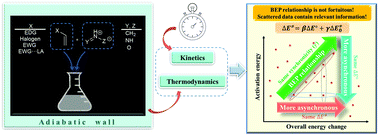A deeper analysis of the role of synchronicity on the Bell–Evans–Polanyi plot in multibond chemical reactions: a path-dependent reaction force constant
Abstract
The role of the degree of synchronicity in the formation of the new single-bonds in a large set of 1,3-dipolar cycloadditions and its relation in the fulfilment of the classical Bell–Evans–Polanyi principle and Hammond–Leffler postulate are deeply investigated. Our results confirm that asynchronicity is an important path-dependent factor to be taken into account: (i) the Bell–Evans–Polanyi is fulfilled as the degree of (a)synchronicity is quite the same, and a linear relationship between reorganisation energy and asynchronicity is found; (ii) the asynchronicity is the origin of deviations of this classical principle of chemical reactivity since any decrease of the energy barrier is due to an increase of asynchronicity at the same exothermicity; and (iii) the less exothermic the reaction is, the more asynchronous the mechanism is, at the same energy barrier. Thus, this implies that TS imbalance decreases the reorganisation energy, consequently affecting the reaction exothermicity as well.

- This article is part of the themed collection: 2022 PCCP HOT Articles


 Please wait while we load your content...
Please wait while we load your content...